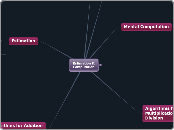av Allison Biagi 13 år siden
634
Estimation and Computation
This Mindomap will focus on different types of estimating to get desired outcomes.

av Allison Biagi 13 år siden
634

Mer som dette
The goal of this map is to outline everything you need to learn about estimation and computation for grades 3-6.
Subtraction using base-ten blocks, is complicated to explain and can only be fully understood if seen visually.
The link posted next to the note will show you how to use this algorithm
When using the expanded algorithm method for subtraction, you start with the greatest number and from there subtract as much as you can do in your head.
Ex: 345
- 16
Since there are no hundreds to subtract
start with tens: 345-10=335
subtract 5 ones: 335-5=330
subtract 1 ones: 330-1=329
So your answer is 329
When you use the standard algorithm to subtract, you always start with the ones and continue subtracting with the help of regrouping, from right to left.
Check the link posted for an example
Expanded algorithms involve adding the values of each place value first, then adding all the sums together to get the final answer
Ex: 525
+123
Add the hundreds column first: 500+100=600
Add the tens column second: 20+20=40
Add the ones column third: 5+3=8
Finally add all the sums together to get the final answer:
600
40
+ 8
648
1
Ex: 525
+ 126
651
When you might use this technique:
You may use this technique if you have a group of numbers that cluster around the same number
How to use:
1) Find the number that all the addends are closest to and that is easy to compute
2) Replace all the addends with the new number you have chosen
3) Use multiplication to compute the total of all the addends
Ex: Number of Dancers
May 23
June 26
July 24
Aug 22
Since all the numbers are around 25, I will take 25 and multiply it by the number of months that are presented. Since there are only 4 months represented in this problem, take 4*25 to get your answer.
The answer is 100 dancers
How to use this technique:
1) Change all the digits except for the leading or front-end digit to zeroes
2) Calculate the total with the numbers you have estimated
EX: 551+376
500+300=800 (change the digits to zeroes except the leading or front-end digits)
51+76=about 125
So 551+376 is about 925
You can use this technique if numbers you estimate are close to the original numbers and are easier to solve the problem with.
To use this technique:
1) Identify the numbers in the original problem that could be replaced with numbers that are close to the original number, but are easier to compute.
EX: original problem- 23*49
since 20 is close to 23 and 50 is close to 49
estimate and solve for 20*50 instead of 23*49
2) Solve the new problem
20*50=1000
Rounding is based on the halfway point between consecutive multiples. For example the halfway point between 10 and 20 is 15. Any numbers that are less than 15 should round down because they are closer to 10. Numbers that are bigger than 15 should round up because they are closer to 20.
Games for Rounding
A division algorithm is a set of rules, calculations or operations to be followed to attain a quotient.
The expanded algorithm for division involves the repeated subtraction of the dividend from the divisor, until you can't subtract anymore.
Ex: 25/5
____
5l 25
- 5
20
- 5
15
- 5
10
- 5
5
- 5
0
So we know that 5 goes into 25, 5 times
The Base-Ten block algorithm for dividing, is a visual way of attaining the desired answer. Using this algorithm you will need to trade when necessary to acquire needed blocks.
A link has been posted for this algorithm
This algorithm includes the formation of only two partial products.
Ex: 32
*14
Multiply: 4*32=128
Multiply: 10*32=320
Add the two partial products: 128
+320
=448
This algorithm involves breaking apart all the numbers in the problem according to the numbers place value and multiplying every digits place value to get the partial product.
Ex: 23
*12
Multiply 2*3=6
Multiply 2*20=40
Multiply 10*3=30
Multiply 10*20=200
When you are finished finding the partial products, add all the sums together to get the final answer.
Answer: 6
40
30
+200
=276
With this technique you first want to substitute a compatiable number for the original number so that it is easier to solve.
EX: you want to buy three packs of toothpaste that cost $2.95 a piece.
A compatiable number for $2.95 would be $3.00
So take 3.00 * 3 (the number of toothpastes you want to buy) to get $9.00
Adding $0.05 to $2.95 three times requires compensating by taking $0.15 away from $9.00.
This leaves you with the answer: $8.85
200+32
400+40
600+72=672